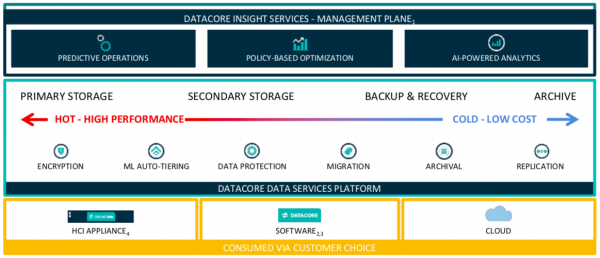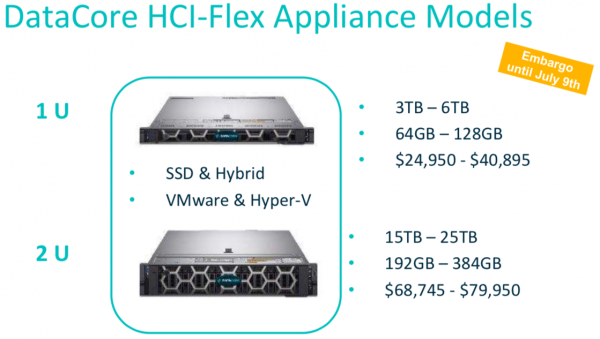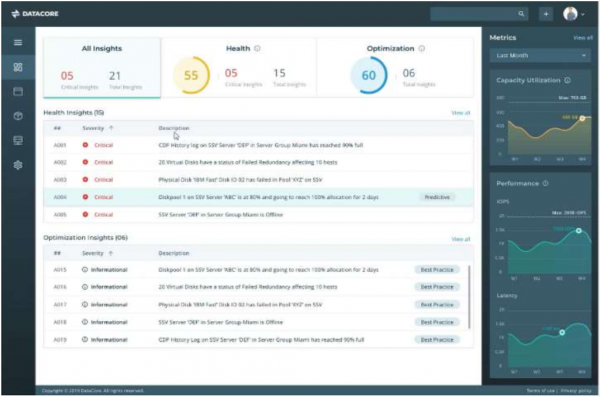DataCore: Analytics Service, Flexible Hyperconverged Appliance, New Capabilities in SDS
Unifying primary, secondary and cloud storage under single management plane with predictive insights to optimize performance and costs
This is a Press Release edited by StorageNewsletter.com on July 9, 2019 at 2:29 pmDataCore Software Corp. announced DataCore ONE, its vision for storage infrastructure, designed to accelerate the adoption of SDS in enterprise data centers, the cloud and edge computing; centralizing command and control of different classes of storage spanning primary, secondary and archive.
It also announced the availability of a number of components that help make this vision a reality, including a flexible hyperconverged infrastructure (HCI) appliance, subscription-based licensing, a new cloud-based analytics service, and enhancements to its software-defined storage technology.
Central to the ONE vision is the new cloud-based predictive analytics engine, DataCore Insight Services (DIS), that provides actionable insights from a 360° view of infrastructure-wide storage.
The SaaS control plane draws on telemetry and the collective learnings from thousands of customers around the globe for early problem detection, best practice recommendations and capacity planning. The combination of ML and AI detects current or foreseeable anomalies in the data storage infrastructure, while the built-in recommendation engine directs designated individuals to the appropriate corrective actions.
The prescribed steps are automated and may be executed remotely from the same web user interface, or performed on-premises behind the firewall, as site-specific security policies dictate. The resulting value is expressed as reduced downtime, faster response, higher efficiencies and substantial cost savings.
Additionally, containerized applications, VMs and bare metal hosts can benefit from virtual storage pools that automatically place hot, moderate and cold data in the most appropriate class of storage.
Architectural flexibility to eliminate silos and lock-in
The new family of DataCore HCI-Flex appliances combine the simplicity of hyperconverged systems with the flexibility of SDS at a competitive price-performance point.
Customers can choose from multiple 1U and 2U configurations with either VMware vSphere or Microsoft Hyper-V pre-installed. All the data services of SDS are included such as smart caching, thin provisioning, dynamic-auto-tiering, and Parallel I/O acceleration, which delivers up to 500% storage performance improvements.
An smart deployment wizard gets the HCI-Flex appliance up and running in a matter of minutes. Once deployed, the appliance can pool and manage internal storage, and also external storage systems as well, regardless of vendor or underlying technology.
The HCI-Flex appliance also enables users to independently scale compute and storage, based on business needs. The flexible deployment model helps eliminate silos and vendor lock-in so customers can transition to HCI on their own terms with confidence. In ROBO and edge computing environments, a synchronously mirrored pair ensures availability without the complexity and cost of 3-node clusters – and is flexible enough to add a third asynchronous replica to a central on-premises location or to a public cloud.
“We’ve heard from many IT leaders around the world about the challenges they face with multiple storage silos and the desire to fully realize the promise of software-defined storage by unifying them under a single intelligent layer. With DataCore ONE, we are delivering on this vision,” said Gerardo A. Dada, CMO, DataCore. “Building on the company’s vast inventory of intellectual property and patents, we are presenting this unified architecture to solidify DataCore as a complete and incredibly flexible software-defined storage platform that will help diverse IT environments achieve the maximum value from storage investments, simplify management, and be ready for the technologies and challenges of the future.”
Intuitive workflows for provisioning, safeguarding, and monitoring
Featuring an extensive UI redesign, firm’s latest software release includes new automation capabilities to help free ITops from procedurally-intensive manual tasks. Now, they can command and control the comprehensive set of data services from a bird’s-eye view through intuitive workflows for provisioning, safeguarding, and monitoring the entire storage infrastructure.
A complete REST API library encourages programmability and further integration with third-party products. New encryption-at-rest technology brings advanced security measures across pools of diverse storage arrays, using military-grade XTS-AES 256-bit encryption algorithms that can be applied across different storage systems. It contrasts with other error-prone approaches that require multiple device-specific runbooks. There are other enhancements in the software release including improved VVOLs management, streamlined deployment, and increased resiliency for metro-cluster environments.
“IT leaders are now counting on software-defined storage to resolve many upcoming challenges… I&O leaders are drawn to software-defined storage for the flexibility of deployment choices (data center, edge, public cloud), as well as the ability to deploy it on industry-standard hardware,” writes Julia Palmer, research VP, Gartner. “By decoupling the software from the industry-standard hardware, I&O leaders can maintain hardware for a longer period without being forced to upgrade and migrate, while avoiding hardware vendor lock-in and forklift upgrades. The flexible pay-as-you-go purchasing model of software-defined storage can also help realize cost-efficiencies.”
More pricing options
DataCore’s new subscription-based model is designed for organizations eager to reduce capital expenditures. Customers can now choose between perpetual or subscription licenses. Both include support and software updates. All licenses are based on capacity with price per terabyte irrespective of number of nodes used for deployment flexibility.
Comments
The death of Ziya Aral (in January 2017), co-founder of DataCore in 1998 with George Teixeira, was really an earthquake for the company and finally triggered the genesis of a new era.
Back to the old days, DataCore was a pioneer of the (SAN) storage virtualization, and by SAN we implicitly mean the block storage domain. In other words SANsymphony, the product acting as a network in-band storage controller, allows the creation of virtual (block) storage pools from any storage to any server all connected to the FC/IP SAN.
It was the past the religion and the mantra of the company and we can admit that DataCore belongs to the small group of SDS pioneer (with Veritas of course). Existing for so long, it was a regular surprise to not read somewhere that the company is acquiring by someone like several other companies in that category (StorageApps acquired by HP in 2001 for approximately $350 million, Troika Networks by QLogic in 2005, StoreAge by LSI in 2006 or Incipient by Texas Memory Systems in 2010... to name a few.
This category illustrates again that innovation comes from small companies and to be honest to justify their existence they have to. The truth was also that Teixeira was a bit greedy, probably too much, and some deals didn't happen, both players staying in their respective positions and guess what nothing happened finally.
This absence of such fact for a hot company in a hot segment invite us to place DataCore in the zombie category, i.e a company existing for a long time not acquired not public with a reduced visibility and never exploding. But the firm had and continues to have an impact on the industry fueled by 10,000 customers, 800 channel partners over 50 countries with a reasonable team of 220 employees.
If you ask someone in the storage industry about DataCore, almost all people should answer "...oh we know what they do, same stuff for many years..." and it was pretty tough to interest people. So back to the trigger event, the company needed a boost and Aral death was finally his final contribution. Sad news and sad contribution but probably a positive effect on the global team, board included.
First it started with several new executives, Teixeira moved to chairman only position, Dave Zabrowski appointed CEO and Gerardo Data CMO with immediately a new logo to reflect that change.
This new team had a mission, they came for it, they defined a new vision ready for its execution and the new era we referred to is visible and officially active.
This new initiative has four pillars:
- DataCore ONE Vision that drives the new DataCore,
- DataCore HCI-Flex appliance,
- DataCore Insight Services (DIS) and
- a new subscription license model.
ONE Vision
It is essentially a layer model with a platform as the foundation available as a new HCI appliance, software or a cloud flavor. Then a set of comprehensive data services for hot to cold data unifying primary, secondary and cloud storage covered by a dashboard. As we see a lot of things already existing and deployed on the market plus new key elements.

HCI-Flex
DataCore finally made it as we though that a natural evolution of SDS is to implement a HCI to go beyond storage. But as just said, storage is not enough but a key component of HCI and HCI is not a storage product as it coupled compute, storage and network to host applications within the infrastructure. The company understands this and offers the needed software component to glue its SDS with an hypervisor like Microsoft Hyper-V or VMware vSphere as pre-installed appliance. This approach continues to unify potential existing external storage to the HCI appliance.

DataCore Insight Services (DIS)
DIS is a cloud-based predictive analytics engine to display real-time and historical trends perfectly aligned with large and aging data storage environment with multiple generation of storage systems and associated data on the entire DataCore installed base. The engineering adds ML and AI to anticipate potential anomalies and state divergence. This product iteration reminds us Nimble Storage InfoSight which finally defines the category, and others have copied this approach.
License options
The firm uses a model based on capacity with a simple price per terabyte that offers real flexibility as it is independent of the DataCore engine. You can deploy 500TB managed by 1 engine or 10TB on each 50 servers for the same total capacity and same price. The new approach is to offer a subscription model in addition to the perpetual existing one.
HCI is already full of players. A new one doesn't change anything but it represents a clever move from DataCore, we were waiting for several years. DIS is key here and it also opens with HCI new business opportunities leveraging a huge installed base.















 Subscribe to our free daily newsletter
Subscribe to our free daily newsletter

